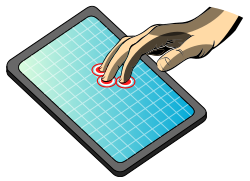
Back لمس متعدد Arabic Multitàctil Catalan Vícedotykové ovládání Czech Multi-touch Danish Multi-Touch-Screen German Multitáctil Spanish چندلمسی Persian Multi-touch Finnish Écran tactile multipoint French מולטי טאץ' HE

In computing, multi-touch is technology that enables a surface (a touchpad or touchscreen) to recognize the presence of more than one point of contact with the surface at the same time. The origins of multitouch began at CERN,[1] MIT, University of Toronto, Carnegie Mellon University and Bell Labs in the 1970s.[2] CERN started using multi-touch screens as early as 1976 for the controls of the Super Proton Synchrotron.[3][4] Capacitive multi-touch displays were popularized by Apple's iPhone in 2007.[5][6] Multi-touch may be used to implement additional functionality, such as pinch to zoom or to activate certain subroutines attached to predefined gestures using gesture recognition.
Several uses of the term multi-touch resulted from the quick developments in this field, and many companies using the term to market older technology which is called gesture-enhanced single-touch or several other terms by other companies and researchers. Several other similar or related terms attempt to differentiate between whether a device can exactly determine or only approximate the location of different points of contact to further differentiate between the various technological capabilities, but they are often used as synonyms in marketing.
Multi-touch is commonly implemented using capacitive sensing technology in mobile devices and smart devices. A capacitive touchscreen typically consists of a capacitive touch sensor, application-specific integrated circuit (ASIC) controller and digital signal processor (DSP) fabricated from CMOS (complementary metal–oxide–semiconductor) technology. A more recent alternative approach is optical touch technology, based on image sensor technology.
- ^ Cite error: The named reference
stumpe77was invoked but never defined (see the help page). - ^ "Multi-Touch Technology and the Museum: An Introduction". AMT Lab @ CMU. 18 October 2015. Retrieved 2020-11-06.
- ^ Crowley-Milling, Michael (29 September 1977). New Scientist. Reed Business Information. pp. 790–791.
- ^ Doble, Niels; Gatignon, Lau; Hübner, Kurt; Wilson, Edmund (2017-04-24). "The Super Proton Synchrotron (SPS): A Tale of Two Lives". Advanced Series on Directions in High Energy Physics. World Scientific. pp. 152–154. doi:10.1142/9789814749145_0005. ISBN 978-981-4749-13-8. ISSN 1793-1339.
- ^ Kent, Joel (May 2010). "Touchscreen technology basics & a new development". CMOS Emerging Technologies Conference. 6. CMOS Emerging Technologies Research: 1–13. ISBN 9781927500057.
- ^ Ganapati, Priya (5 March 2010). "Finger Fail: Why Most Touchscreens Miss the Point". Wired. Archived from the original on 11 May 2014. Retrieved 9 November 2019.